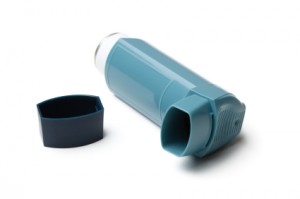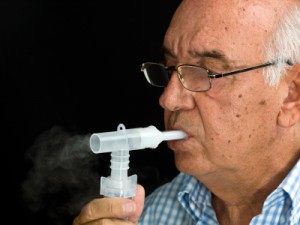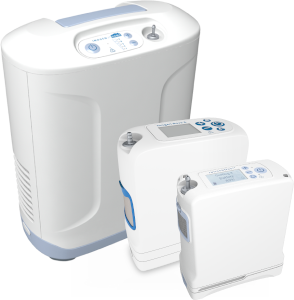If you or someone you love has been diagnosed with chronic lung disease, you will be learning about a variety of drugs for lung disease and other breathing treatment. With all the new information, you might find yourself wondering, “What are breathing treatments used for?” When it comes to breathing treatment meds, it is helpful to know the basics so you understand the various types and pharmaceutical treatment and how they are used.
What Are Breathing Treatments Used For?[1]
Breathing treatments are prescribed for a number of conditions, such as: COPD, asthma, pneumonia, and other respiratory conditions. They help you to breathe better by turning medications into mist with the use of an inhaler or nebulizer device. They can treat wheezing, shortness of breath, asthma, COPD, and more. Breathing treatments can take place at home or in a medical setting. Breathing treatment medications include bronchodilators to relax and open airways; corticosteroids to reduce airway inflammation; mucolytics to loosen, thin and clear mucus secretions from the lungs, antimicrobials to treat respiratory infections and combination medications that combine the benefits of more than one medication. Additionally racemic epinephrine medications are primarily used to treat severe asthma attacks, croup, and other emergency breathing difficulties.
Breathing treatment meds are used to help you breathe better, but they work in very different ways.
It is important to talk to your doctor about how to use your breathing treatments correctly, including frequency of use and how quickly you can expect the treatment to help. You should also be clear on when to seek medical attention if your breathing treatment is not providing adequate relief.
Bronchodilators
Bronchodilators commonly are prescribed for people with COPD. Bronchodilators relax the muscles around your airways so that you can breathe better. They usually come in the form of an inhaler, which allows the medicine quick access to your lungs as you breathe it in. Two of the most commonly used classes of bronchodilators are beta agonists and anticholinergics.[2]
Beta-adrenergic bronchodilators dilate bronchial airways by relaxing the muscles that surround the airways. Beta-adrenergic bronchodilators are beta-2 agonists. These medications stimulate beta-2 receptors on the smooth muscle cells that line the airways, causing these muscle cells to relax, thus, opening airways.[3]
Anticholinergic bronchodilators block the effect of acetylcholine on airways and nasal passages. Acetylcholine is a chemical that nerves use to communicate with muscle cells. The “anticholinergic” effect of anticholinergic bronchodilators blocks the effect of cholinergic nerves, causing the muscles to relax and airways to dilate.[3]
Short-acting bronchodilators offer quick relief. They typically start working in 15 to 30 minutes, and last about four to six hours. Your doctor may prescribe a short-acting bronchodilator if your COPD is mild and you only have symptoms every once in a while. Examples of short-acting bronchodilators are albuterol (Ventolin HFA, and other brand names), levalbuterol (Xopenex) and ipratropium (Atrovent HFA).[2]
Most long-acting bronchodilators don’t act as quickly but last longer — 12 to 24 hours or more — to relieve symptoms. Long-acting bronchodilators usually are prescribed when symptoms occur frequently. These medications act as maintenance therapy by keeping symptoms from developing in the first place. Most are not as good at providing immediate relief. Examples of long-acting bronchodilators are formoterol (Foradil, Perforomist), salmeterol (Serevent), and tiotropium (Spiriva), and there are numerous others.[2]
Additionally, xanthine derivatives open airways by relaxing the smooth muscles in the walls of the airways and they also suppress the response of the airways to stimuli. Aminophylline and theophylline are two types of xanthine derivatives. Taken in pill form, there are also short- and long-lasting formulations of theophylline, but no fast-acting formula. Your doctor will have to monitor the levels of the drug in your blood very carefully, because these drugs for lung disease can cause serious side effects if those levels get too high. Your doctor will go over these side effects with you and, as with any pharmaceutical treatments, you should seek medical advice immediately if you encounter any problems. Theo-24® and Elixophyllin®, are two brands of theophylline.[3]
If your COPD is moderate to severe, your doctor likely will recommend both types — a short-acting bronchodilator for quick relief when needed and one or more long-acting ones that you take every day to keep symptoms at bay. Consider labeling each with a marker, so you can quickly tell which is for quick relief and which is for regular treatment.[2]
Short-acting beta-adrenergic bronchodilators and ipratropium work quickly and are used for acute management of asthma episodes. Long-acting beta-adrenergic bronchodilators, tiotropium, and theophylline are used daily and long-term for preventing asthma attacks or reducing the frequency of symptoms.[3]
MUCOLYTICS
For cystic fibrosis patients, or some COPD patients where excess mucus production is a major problem, your doctor may prescribe mucus-thinning medications called mucolytics. These drugs for lung disease make the excess mucus less sticky and easier to expel, thus helping you to breathe better. These come in tablet or liquid form. Many people have allergic reactions to these breathing treatment meds, so speak with your doctor thoroughly before trying these products. Acetylcysteine (Mucomyst®) is one kind of mucolytic medicine currently on the market.[1]
ANTIBIOTICS
In some cases, you may be prescribed antibiotic breathing treatment to deal with an acute bacterial infection that results in severe symptoms of chronic bronchitis. Note that antibiotic breathing medicine only works for these kinds of infections, and not for viral infections. Typically, these are the same kinds of antibiotics you have probably taken before; however, they are not an effective breathing medicine for treating symptoms of COPD over a long-term period of time. Commonly used brands include Augmentin®(amoxicillin / clavulanate), Zithromax® (azithromycin), and Avelox® (moxifloxacin hydrochloride).[1, 2]
If you have frequent exacerbations despite daily use of a long-acting bronchodilator, talk to your doctor. A combination with additional medicines may work better for you.
BREATHING TREATMENT DELIVERY METHODS: INHALERS AND NEBULIZERS
For people using inhaled bronchodilators and steroids to treat their lung disorder, there are two primary devices used to administer the breathing treatment medicine. One is an inhaler, very common for asthma patients and very easy to use. The other is a nebulizer, used in conjunction with liquid formulations of certain kinds of medication.[4]

Inhalers: There are two types of inhalers: a metered-dose inhaler (MDI) and a dry-powder inhaler.
An MDI is the most common type of inhaler. Using one involves inhaling a premeasured amount of medicine through a mouthpiece. Some inhalers have a spacer, which makes it easier to inhale the medication.
A dry-powder inhaler is similar, but the medication is in powder form inside the inhaler. It requires the user to take a deep, fast breath, which pulls the powdered medicine deep into the lungs.
Both types require the ability to inhale the medicine deep within the lungs. Some children and people with severe respiratory diseases may find this problematic.[4]
Nebulizers: Nebulizers tend to be a little easier to use, in terms of delivering the medicine. However, a nebulizer may take up to 10 minutes to dispense the medication, and the user needs to sit still until they have inhaled all of it, which may be hard for a young child. Also, nebulizers are not as portable; they can be difficult to carry around, while inhalers are typically smaller and more suitable for traveling.[4]
The breathing treatments generally involve these steps:[1]

- Wash your hands with soap and water before assembling a nebulizer device.
- Place the exact amount of prescribed liquid medication in the nebulizer medicine cup.
- Connect the hose from the nebulizer device to the air compressor.
- Attach the mouthpiece or mask to the medicine cup.
- Turn on the device and take slow, deep breaths until the liquid medication is gone.
- Rinse the mouthpiece and medicine cup with warm water and let them air dry.
Your respiratory therapist or doctor will show you how to use the nebulizer before you begin to use it.[1]
Talk to your doctor about which drugs for lung disease might help you. In addition, ask about other treatments, like oxygen therapy. If you have questions about oxygen therapy breathing treatment, contact Inogen today to learn more.
Frequently Asked Questions: Breathing Treatment
HOW DO YOU KNOW IF YOU NEED A BREATHING TREATMENT?
Your doctor will decide if you should have a prescription for breathing medicine. However, once you have a prescription, you may be responsible for deciding when you need a breathing treatment, depending on your breathing treatment meds. Your doctor will give you guidance on how much and how frequently to use your breathing medicine, but inhaler and nebulizer drugs for lung disease are typically taken as needed. You will begin to recognize symptoms and signs that indicate you need a breathing treatment, including: wheezing, shortness of breath or coughing. Seek immediate medical attention if your breathing does not respond to or gets worse after a breathing treatment, you lose consciousness, have sever dizziness or light headedness due to breathing issues or show signs or respiratory distress, such as blue skin.[5] It is a good idea to ask your doctor or healthcare team to give you a list of warning signs so that you feel prepared.
HOW OFTEN CAN I TAKE A BREATHING TREATMENT?
That varies with each medication, and can vary depending on how the breathing medicine is administered. As such, it is important to follow your doctor’s instructions in regards to frequency of use. Always speak with your doctor about the limits of use for your particular breathing treatment meds.
HOW LONG DOES A BREATHING TREATMENT LAST?
That depends entirely on your breathing treatment meds, your prescription, the flow on your nebulizer and your unique illness. The average nebulizer treatment takes about 10 minutes, but could take up to 20 minutes with certain breathing treatment meds. Inhaler treatments are almost instant.[2] How quickly an oral pharmaceutical treatment depends entirely upon that particular medication formulation. Talk with your doctor about how long inhaled treatments will take, as well as how long you should expect to wait before oral medications are effective.
HOW DO BREATHING TREATMENTS HELP?[1]
Breathing treatments are prescribed for a number of conditions, such as: COPD, asthma, pneumonia, and other respiratory conditions. They help you to breathe better by turning medications into mist with the use of an inhaler or nebulizer device. They can treat wheezing, shortness of breath, asthma, COPD, and more. Breathing treatments can take place at home or in a medical setting. Breathing treatment medications include bronchodilators to relax and open airways; corticosteroids to reduce airway inflammation; mucolytics to loosen, thin and clear mucus secretions from the lungs, antimicrobials to treat respiratory infections and combination medications that combine the benefits of more than one medication. Additionally racemic epinephrine medications are primarily used to treat severe asthma attacks, croup, and other emergency breathing difficulties.
It is important to talk to your doctor about how to use your breathing treatments correctly, including frequency of use and how quickly you can expect the treatment to help. You should also be clear on when to seek medical attention if your breathing treatment is not providing adequate relief.
CAN A NEBULIZER BE USED WITHOUT MEDICINE?[6]
There are several types of medication that a person can use with a nebulizer:
- Bronchodilators: These are drugs that help open the airways and make breathing easier. Doctors often prescribe bronchodilators to people with asthma, COPD, or other respiratory disorders.
- Sterile saline solution: A nebulizer can deliver sterile saline to help open the airways and thin secretions. This may loosen and make it easier to cough up mucus in the lungs.
- Antibiotics: A nebulizer can deliver some types of antibiotics straight into the lungs or respiratory tract when someone has a severe respiratory infection.
WHAT IS THE DIFFERENCE BETWEEN AN INHALER AND A NEBULIZER?[6]
Nebulizers and inhalers have some similarities — for example, they both deliver medicine directly into the lungs to help make breathing easier. However, there are some important differences.
There are two types of inhalers: a metered-dose inhaler (MDI) and a dry-powder inhaler. An MDI is the most common type of inhaler. Using one involves inhaling a premeasured amount of medicine through a mouthpiece. Some inhalers have a spacer, which makes it easier to inhale the medication. A dry-powder inhaler is similar, but the medication is in powder form inside the inhaler. It requires the user to take a deep, fast breath, which pulls the powdered medicine deep into the lungs. Both types require the ability to inhale the medicine deep within the lungs. Some children and people with severe respiratory diseases may find this problematic.
Nebulizers tend to be a little easier to use, in terms of delivering the medicine. However, a nebulizer may take up to 10 minutes to dispense the medication, and the user needs to sit still until they have inhaled all of it, which may be hard for a young child. Also, nebulizers are not as portable; they can be difficult to carry around, while inhalers are typically smaller and more suitable for traveling.
WILL I FEEL PAIN WITH BREATHING TREATMENTS?
Breathing treatments should take getting used to, but should not cause any pain at all. While you may experience discomfort as a result of your breathing difficulties, the breathing treatments are made to help ease those symptoms. If you experience any pain while receiving your breathing treatments or immediately following them, let your doctor or healthcare team know right away. Never use a breathing treatment more than recommended.[1]
WHAT ARE THE RISKS AND POTENTIAL COMPLICATIONS OF BREATHING TREATMENTS?[1]
Medications for breathing treatments may have some potential side effects. Side effects depend upon the type and strength of the medication, but may include:
- faster heartbeat
- dry mouth
- headache
- mild tremor
- glaucoma
Some medications may also cause side effects if they get into the eyes or on your skin when using a mask. Your doctor may advise that you use a mouthpiece instead. Drug interactions and pregnancy and breastfeeding safety information should be reviewed prior to taking any medication.
If you experience the following serious side effects[3] when using your breathing treatments as recommended, seek immediate medical attention.
|
|
Beta-adrenergic bronchodilators |
Anti—cholinergic Bronchodilators |
Xanthine derivatives |
|
Bronchospasm (worsening of asthma) |
x |
x |
|
|
Serious allergic reactions (anaphylaxis) |
x |
x |
|
|
Low potassium |
x |
|
|
|
Abnormal heart rhythm (palpitations) |
x |
|
|
|
Fast heart rate, arrhythmias |
x |
|
x |
|
Elevated blood pressure |
x |
|
|
|
Chest pain |
x |
|
|
|
Worsening symptoms of benign prostatic hyperplasia |
|
x |
|
|
Worsening symptoms of narrow-angle glaucoma |
|
x |
|
|
Seizures |
|
|
x |
|
Shock |
|
|
x |
|
Hypotension |
|
|
x |
|
Exfoliative dermatitis |
|
|
x |
HOW DO I PREPARE FOR MY BREATHING TREATMENT?[1]
Prepare for your breathing treatment by making sure you are well informed and prepared to administer your breathing treatments confidently. Start by asking your health care team for clear, step-by-step instructions on how to properly administer your breathing treatment. Make sure you write everything down, or ask them to print out a copy of instructions for you. It is also important that you know what to expect during and after your treatment. Ask about any sensations to expect, as well as how to tell if you are doing your treatment correctly. If you are trying new types of bronchodilators, ask how they differ from any kind you used previously. Talk to your doctor about how to troubleshoot issues with equipment if it seems like it is not working properly. Lastly, make sure you know how to tell if your breathing treatment is not working, and what you should do at that point. Make sure you know who to contact for more information. There is a small learning curve when using new breathing treatments, but being prepared will help you get used to the process as quickly as possible.
REFERENCES
- Spader, “Breathing Treatments.” Healthgrades, 5 Sept. 2019, www.healthgrades.com/right-care/lungs- breathing-and-respiration/breathing-treatments.
- Mayo Clinic Q and A: COPD treatment with two types of bronchodilators – Mayo Clinic News Network
- BRONCHODILATOR – AEROSOL ORAL INHALER side effects, medical uses, and drug interactions. (medicinenet.com)
- https://www.carewell.com/resources/blog/nebulizer-vs-inhaler/
- Breathing treatments: What can help? (medicalnewstoday.com)
- What is a nebulizer? Who needs one and why (medicalnewstoday.com)
- Breathing Treatment: Asthma, COPD, and More (healthline.com)
NOTES
VENTOLIN HFA is00 a registered trademark of GSK
Xopenex® is a registered trademark of Akorn, Inc
Atrovent® is a registered trademark of Boehringer Ingelheim.
FORADIL® is a registered trademark of Astellas Pharma Inc
Performist® is a registered trademark of Mylan Specialty L.P., a Viatris Company.
Serevent Diskus is manufactured, marketed and/or distributed by GlaxoSmithKline
Sprivia® Respimate® is a registered trademark of Boehringer Ingelheim Pharmaceuticals
Theo-24® is a registered trademark of Endo Pharmaceuticals
Elixophyllin® Elixir is a registered trademark of Nostrum Pharmaceutical
Mucomyst® is a registered trademark of E.R. Squibb & Sons, L.L.C.
Augmentin™ is a registered trademark of GlaxoSmithKline LLC Zithromax® is a registered trademark of Pfizer
Avelox® is a registered trademark of Bayer Aktiengesellschaft and is used under license by Merck Sharp & Dohme Corp., a subsidiary of Merck & Co., Inc.
Daliresp









